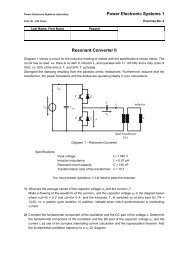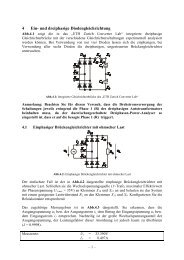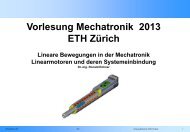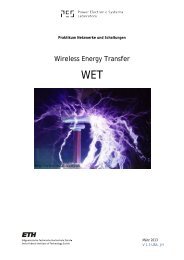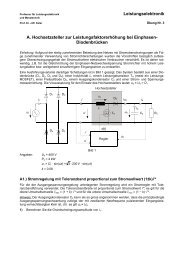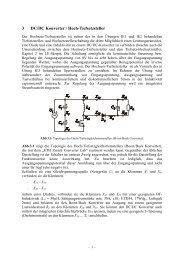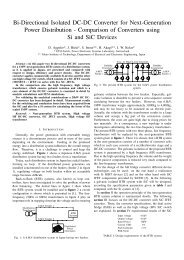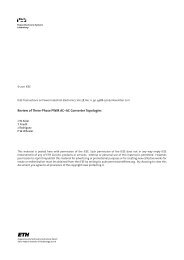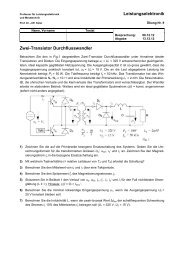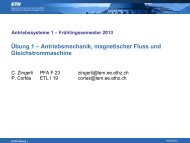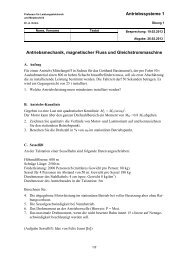U. Badstübner, J. Biela, J. W. Kolar, Power Density and Efficiency ...
U. Badstübner, J. Biela, J. W. Kolar, Power Density and Efficiency ...
U. Badstübner, J. Biela, J. W. Kolar, Power Density and Efficiency ...
You also want an ePaper? Increase the reach of your titles
YUMPU automatically turns print PDFs into web optimized ePapers that Google loves.
<strong>Power</strong> <strong>Density</strong> <strong>and</strong> <strong>Efficiency</strong> Optimization<br />
of Resonant <strong>and</strong> Phase-Shift Telecom DC-DC Converters<br />
U. Badstuebner, J. <strong>Biela</strong> <strong>and</strong> J. W. <strong>Kolar</strong><br />
<strong>Power</strong> Electronic Systems Laboratory, ETH Zurich<br />
ETH-Zentrum, ETL H12, Physikstrasse 3<br />
CH-8092 Zurich, Switzerl<strong>and</strong><br />
Email: badstuebner@lem.ee.ethz.ch<br />
Abstract—<strong>Power</strong> density <strong>and</strong> efficiency are one of the major<br />
driving forces in the development of new power supplies for<br />
telecommunication <strong>and</strong> information industry. The phase-shift<br />
PWM <strong>and</strong> the series-parallel resonant DC-DC converter are<br />
promising topologies that can meet these dem<strong>and</strong>s at high power<br />
rates. Based on conventional criteria such as the number of<br />
semiconductors/passive components or voltage/current stress it<br />
is not possible to identify the topology that offers a higher power<br />
density or efficiency.<br />
Therefore, an optimization procedure has been developed,<br />
which calculates the optimal converter parameters (e.g. switching<br />
frequency or transformer design) with respect to the maximal<br />
power density <strong>and</strong>/or efficiency. This procedure is based on<br />
detailed analytical models for the converter, semiconductor losses,<br />
HF losses in the magnetic components as well thermal <strong>and</strong><br />
geometrical models of the transformer.<br />
With the procedure a 5 kW series-parallel resonant converter<br />
<strong>and</strong> a phase shift converter with capacitive output <strong>and</strong> with<br />
current doubler have been optimized. With the calculated<br />
parameters a resonant converter prototype has been constructed<br />
<strong>and</strong> experimental results are presented.<br />
I. INTRODUCTION<br />
Over the last decades, a major effort in the information<br />
<strong>and</strong> telecommunication industry has been increasing the power<br />
density of the deployed power supplies in order to meet<br />
the design requirements concerning maximum weight, limited<br />
space <strong>and</strong> production costs [1]. The increasing density has<br />
been mainly enabled by the continuous development of high<br />
performance switching devices which allow a higher switching<br />
frequency at relatively low switching losses, what leads to a<br />
reduced volume of the passive components.<br />
Besides the power density, system efficiency is a major driving<br />
force due to the continual increase of energy consumption<br />
<strong>and</strong> costs. Therefore, the development focuses now on high<br />
efficiency power supplies, which enable cost <strong>and</strong> cooling effort<br />
reduction.<br />
Switch mode power supplies applied in telecommunication<br />
systems <strong>and</strong> data centers typically consist of an AC-DC<br />
rectifier with power factor correction (PFC) as input stage <strong>and</strong><br />
Table I: Typical specifications of IT DC-DC converter.<br />
Input voltage V IN 400 V<br />
Output voltage V OUT 48. . . 54 V<br />
Output power P OUT 5 kW<br />
Output ripple voltage V ripple 300 mV pp<br />
Max. ambient temperature T amb 45 ◦ C<br />
Rectifier<br />
4 MOSFETs<br />
Gate Drives<br />
Digital Control Board<br />
Fan<br />
Series Capacitor C s<br />
Transformer<br />
with Integrated<br />
Series Inductance L s<br />
Prototype: Height: 1 U = 1.75 in ≈ 44 mm, volume: 0.49 liter, power<br />
density: 167 W/in 3 = 10.2 kW/liter<br />
+<br />
VIN<br />
-<br />
C IN<br />
s11<br />
A<br />
IP<br />
s12<br />
B<br />
s21 s 22<br />
a) LC-filter<br />
L OUT<br />
COUT<br />
C P<br />
C<br />
NS<br />
S L S<br />
VAB NP<br />
IS IR1<br />
N S<br />
C P<br />
IR2<br />
COUT<br />
b) C-filter<br />
Schematic: a) LC-filter <strong>and</strong> b) capacitive filter as output stage<br />
Figure 1: Prototype <strong>and</strong> schematic of a series-parallel resonant<br />
DC-DC converter, 5 kW, 400 V/48..54 V.<br />
a DC-DC converter as output stage, which steps the DC link<br />
voltage down to the required output voltage of 48 V to 54 V.<br />
There, usually transformers, enabling a large voltage transfer<br />
ratio, are applied for galvanic isolation (e.g. [2],[3]).<br />
The typical specifications for IT DC-DC converters are<br />
given in table I. In the literature several topologies for<br />
the rectifier <strong>and</strong> DC-DC converter have been proposed (e.g.<br />
[4][11]). A comparison of these topologies based on criteria<br />
like stress of the semiconductors, number of switches or<br />
IS<br />
N S<br />
NS<br />
IR1<br />
IR2<br />
IOUT<br />
IOUT<br />
+<br />
VOUT<br />
-<br />
+<br />
V OUT<br />
-
ZVS/ZCS condition only allows to reduce the number of<br />
topologies to a few promising ones. For a more detailed comparison<br />
identifying the most suitable topology, an optimization<br />
of each topology with respect to the considered comparison<br />
criteria, power density <strong>and</strong> efficiency, is required.<br />
Therefore, a comparison of different DC-DC converters<br />
topologies based on an optimization procedure with comprehensive<br />
analytical models is presented in this paper. The<br />
most suitable topologies for high power telecom converters<br />
are the series-parallel resonant converter (schematic <strong>and</strong> the<br />
constructed hardware based on the optimization procedure are<br />
shown in Fig. 1) <strong>and</strong> the phase-shift PWM converter (cf.<br />
Fig. 2), which both allow soft-switching. For these two<br />
converters different output stages (LC-filter, C-filter with mid<br />
point connection <strong>and</strong> current doubler) are possible <strong>and</strong> have<br />
been investigated [12].<br />
A short survey on applicable topologies <strong>and</strong> an evaluation,<br />
based on the mentioned criteria with respect to the achievable<br />
power density <strong>and</strong> efficiency, is given in in Section II. There,<br />
also the operation of the phase-shift <strong>and</strong> the series-parallel<br />
resonant converter including the digital control using a state<br />
machine is shortly explained. For the topology comparison<br />
a comprehensive optimization procedure is required, which<br />
is presented in Section III with the corresponding different<br />
analytical models for the converters such as the HF transformer<br />
losses <strong>and</strong> the temperature distribution.<br />
With the presented optimization procedure the two topologies<br />
have been optimized, once for power density <strong>and</strong> once<br />
for maximum efficiency. The corresponding results of the<br />
optimization <strong>and</strong> a comparison of both converter topologies are<br />
discussed in Section IV. In the same section a validation of the<br />
resulting optimized parameters based on a circuit simulation is<br />
given. For validating the results a prototype <strong>and</strong> measurement<br />
results of an optimized series-parallel resonant converter are<br />
presented in Section V. There, also the design of a phase-shift<br />
converter with current doubler <strong>and</strong> the comparison between<br />
copper <strong>and</strong> aluminum heat sinks is given.<br />
II. CONVERTER TOPOLOGIES FOR IT APPLICATIONS<br />
In the area of low power converters often flyback <strong>and</strong><br />
single switch forward converters are applied. These topologies<br />
are not suitable if high output power with high efficiency<br />
is required. Enhanced <strong>and</strong>/or other topologies proposed for<br />
telecom supplies are, for example, the double interleaved forward<br />
converter [4], [13], the asymmetrical half bridge [5] <strong>and</strong><br />
multiresonant topologies [7]. However, these topologies do<br />
not fit the requirements concerning efficiency <strong>and</strong> high power<br />
density in the same way as full bridge topologies, operating<br />
with soft switching, due to the amount of semiconductors<br />
<strong>and</strong> passive components <strong>and</strong>/or the utilization of the duty<br />
cycle in half brides which results in larger transformers. In<br />
addition, the switching <strong>and</strong> conduction losses in asymmetrical<br />
half bridges increase <strong>and</strong> the efficiency decreases due to the<br />
asymmetrical current waveforms at high input voltages [6].<br />
As already mentioned in section I, the series-parallel resonant<br />
(cf. Fig. 1 bottom) <strong>and</strong> the phase-shift PWM fullbridge<br />
DC-DC converter (cf. Fig. 2) are well applicable for<br />
the considered telecom application. Both converters operates<br />
+<br />
VIN<br />
-<br />
C IN<br />
s11 s 12<br />
A<br />
s 21<br />
I P<br />
B<br />
s22<br />
V AB<br />
L σ<br />
N P<br />
a) Current doubler<br />
N S<br />
NS<br />
2N S<br />
b) C-filter<br />
L S1<br />
C OUT<br />
+<br />
V OUT<br />
LS2<br />
I OUT<br />
I OUT<br />
C OUT<br />
+<br />
Figure 2: Schematic of a phase-shift DC-DC converter with a)<br />
current doubler or b) center-tapped transformer with LC-filter.<br />
with soft-switching <strong>and</strong> enable high efficiency at higher output<br />
power levels. In addition, full-bridge converters better utilize<br />
the transformer due to the bipolar flux swing. Therefore, a<br />
smaller transformer size <strong>and</strong> weight can be achieved.<br />
A. Phase-Shift PWM DC-DC Converter<br />
When operating a conventional PWM full bridge at high<br />
power <strong>and</strong> high frequency, the converter performance will be<br />
reduced by the switching losses due to the circuit parasitics. A<br />
specially-operating mode of the PWM full bridge, allows all<br />
switching devices (cf. Fig. 2) to operate under zero voltage<br />
(ZVS) condition (e.g. in [2], [11]). There, the parasitics of the<br />
circuit are advantageously used to achieve the soft-switching<br />
condition.<br />
In Fig. 2 two possible output stages are shown: a mid<br />
point connection with C-filter (CTC) <strong>and</strong> the current doubler<br />
(CDR). Both topologies enable a compact construction with<br />
high efficiency <strong>and</strong> will be considered in the optimization.<br />
In Fig. 3 the control scheme <strong>and</strong> the principle voltage/current<br />
waveforms of the phase-shifted PWM converter<br />
are given. There, the power flow is controlled by the<br />
phase-shift between the two legs, which also determines<br />
the duty cycle of the converter. The switching of all four<br />
IGBTs/MOSFETs is performed under ZVS condition by using<br />
the energy stored in the leakage inductance (L σ , cf. Fig. 2),<br />
in order to charge/discharge the parasitic output capacitances<br />
of both switches in the switching leg. Further details can be<br />
found in literature mentioned above.<br />
B. Series-Parallel Resonant DC-DC Converter<br />
The series-parallel resonant converter is a combination of a<br />
series <strong>and</strong> a parallel resonant DC-DC converter, as shown in<br />
Fig. 1. With a proper choice of the resonant tank components<br />
values (C S , L S <strong>and</strong> C P ), the series-parallel resonant converter<br />
combines the advantages of the series resonant converter:<br />
• Series capacitor C S blocks the DC voltage, thus avoiding<br />
the transformers saturation<br />
• The partial load efficiency is high due to the decrease in<br />
device currents with a decrease in load<br />
<strong>and</strong> the advantages of the parallel resonant converter:<br />
• Controlled operation at light load<br />
VOUT<br />
-
1 2 3 4<br />
Table II: Constraints used for the optimization procedure<br />
(CSPI = Cooling System Performance Index cf. [17]).<br />
s 11<br />
s 21<br />
s 12<br />
s 22<br />
V IN<br />
s11 s12 I P<br />
A B<br />
s21<br />
s 22<br />
Leg A Leg B<br />
s11<br />
s21<br />
s12<br />
s22<br />
I P<br />
s11<br />
s21<br />
s12<br />
s22<br />
I P<br />
s11<br />
s21<br />
s 12<br />
s 22<br />
I P<br />
t<br />
t<br />
t<br />
Max. Width<br />
1 U = 1.75 in ≈ 44 mm<br />
Core Material N87 (EPCOS, T max ≤ 115 ◦ C)<br />
MOSFETs<br />
APT50M75 (Mircosemi, former APT)<br />
Rectifier Diodes APT100S20 (Mircosemi, former APT)<br />
Capacitors C S <strong>and</strong> C P 3.9 nF, 800 V, COG (NOVACAP)<br />
CSPI 23<br />
Max. Junction Temp. T j,max ≤ 140 ◦ C<br />
V AB<br />
SPR<br />
+V IN CTC<br />
CDR<br />
Figure 3: Switching states <strong>and</strong> current waveforms for phaseshift<br />
converter with capacitive output filter <strong>and</strong> current doubler<br />
as well as for the series-parallel resonant DC-DC converter<br />
with capacitive output filter.<br />
while most of the disadvantages of the two converters are<br />
eliminated (e.g. [6], [9], [14]. Furthermore, the converter<br />
is naturally short circuit proof.<br />
For a compact design, a center-tapped transformer with<br />
rectifier as output stage results in a lower volume if high output<br />
currents are required. As presented in [8], the capacitive output<br />
filter (cf. Fig. 1 b) results in a smaller volume than the LCfilter<br />
for high output currents. Therefore, the LC-filter is not<br />
considered in the following.<br />
As the phase-shifted converter, the series-parallel resonant<br />
converter provides soft switching of all 4 switches. By<br />
controlling the zero-crossing of the resonant current I P it is<br />
possible to achieve zero-voltage switching in one leg <strong>and</strong> zerocurrent<br />
switching (ZCS) in the other one.<br />
The operation principle of the switches is similar to the<br />
phase-shifted converter as shown in Fig. 3. Due to the<br />
filtering action of the resonant circuit the primary current I P<br />
is approximately sinusoidal, which has the benefit of better<br />
EMI performance.<br />
As it can be seen in the schematics (Fig. 1b) <strong>and</strong> Fig.<br />
2) <strong>and</strong> the control scheme (cf. Fig. 3), the phase-shift <strong>and</strong><br />
the resonant converter are very similar <strong>and</strong> show almost the<br />
same performance <strong>and</strong> similar efficiency (e.g. [3]). Thus,<br />
conventional criteria are not sufficient to identify the most<br />
suitable especially in respect to minimal volume, lowest cost<br />
or highest efficiency. By means of optimizing the three<br />
converter topologies for one or even more criteria like power<br />
density <strong>and</strong>/or efficiency based on detailed models, a profound<br />
comparison based on the optimization is possible. This<br />
optimization procedure <strong>and</strong> the associated models described<br />
in the following section.<br />
-V IN<br />
III. OPTIMIZATION PROCEDURE<br />
For the comparison of the different topologies, the component<br />
values must be chosen, so that the power density<br />
<strong>and</strong>/or the efficiency becomes maximal. Since the volume<br />
of the single components, which are mainly limited by the<br />
respective maximum operation temperature, interdependent to<br />
some extent on each other, the optimization of the overall<br />
volume is a quite difficult task with many degrees of freedom.<br />
Therefore, an automatic optimization procedure is applied for<br />
determining the optimal component values of the telecom<br />
supply.<br />
The optimization procedure is mainly based on 4 models:<br />
• An analytical converter model, based on the extended<br />
fundamental analysis (series-parallel resonant converter,<br />
[8], [15]) <strong>and</strong>/or time domain analysis (phase-shift converter,<br />
[16]), respectively<br />
• Equations for the semiconductor switching <strong>and</strong> conduction<br />
losses, based on measurements<br />
• Model for the volumes of the resonant tank capacitors,<br />
including dielectric losses<br />
• A model of the losses <strong>and</strong> the temperature distribution<br />
in the transformer with integrated series inductance for<br />
optimizing the transformer geometry.<br />
In the following the optimization procedure will be explained<br />
briefly. There, also references where the models are explained<br />
in detail are listed.<br />
The starting point of the procedure is the initialization<br />
of the design parameters like input voltage, output power,<br />
temperature limits <strong>and</strong> material characteristics as presented<br />
partially in table I <strong>and</strong> table II. These parameters as well<br />
as starting values like C S , C P , L S , L Out1,2 <strong>and</strong> the number<br />
of turns of the transformer (N P <strong>and</strong> N S ) must be specified by<br />
the user.<br />
With the values for the magnetic components <strong>and</strong> the turns<br />
number the model for the magnetic components is parameterized.<br />
There, a reluctance model of the transformer with integrated<br />
inductance in combination with the analytical converter<br />
model, which describes the operation of the converter <strong>and</strong> the<br />
flux distribution in the core is used in case of the resonant<br />
converter [8], [15]. The models for the phase-shift converters<br />
are based on analytical expression for the flux distribution <strong>and</strong><br />
the optimal winding geometry [18].<br />
With the frequency, duty cycle, currents <strong>and</strong> voltages resulting<br />
from the analytical converter model [8], [15], the value <strong>and</strong><br />
volumes of resonant tank capacitors as well as the switching<br />
<strong>and</strong> conduction losses in the MOSFETs <strong>and</strong> rectifier diodes<br />
are determined, based on the models presented in [8]. These<br />
losses, the ambient temperature <strong>and</strong> the maximum junction<br />
temperatures of the semiconductor devices are used for calcu-
lating the volume of the semiconductor heat sink including the<br />
fan based on the CSPI (Cooling System Performance Index)<br />
[17]:<br />
CSPI [ ]<br />
W<br />
1<br />
Kdm = [ 3<br />
R K<br />
] (1)<br />
th,S−a W V olCS [liter]<br />
with the thermal resistance R th,S−a of the heat sink <strong>and</strong> the<br />
volume of the heat sink including fan V ol CS .<br />
The volume <strong>and</strong> the shape of the transformer/inductor core<br />
<strong>and</strong> the two windings is determined in a second, inner optimization<br />
procedure, based on a transformer model as presented<br />
in [8], [15]. There, the volume of the transformer/inductor is<br />
minimized while keeping the temperatures below the allowed<br />
limits. The temperature distribution in the core/winding is<br />
calculated with a thermal model <strong>and</strong> the core <strong>and</strong> the winding<br />
losses (including HF-losses).<br />
The resulting minimized transformer/inductor volume are<br />
passed to the global optimization algorithm together with the<br />
volumes of the heat sink <strong>and</strong> capacitors. Based on the result<br />
the free parameter values are systematically varied until a<br />
minimal system volume <strong>and</strong>/or maximal efficiency is obtained.<br />
More detailed information about the optimization <strong>and</strong> the<br />
corresponding models can be found in [1], [8], [12], [15]<br />
IV. OPTIMIZATION AND SIMULATION RESULTS<br />
Based on the optimization procedure presented in the preceding<br />
section the three considered topologies – phase shift<br />
with capacitive output filter <strong>and</strong> current doubler as well as the<br />
resonant converter with capacitive output filter – have been<br />
optimized for the data given in table I <strong>and</strong> II. The resulting<br />
operating parameters are presented in table III.<br />
The highest power density is achieved with the seriesparallel<br />
resonant converter: 19.1 kW/ltr. (313 W/in 3 ) if only<br />
the net component volumes, the PCBs <strong>and</strong> housings are<br />
considered. The final system volume strongly depends on<br />
the 3D design of the converter. For the prototype shown in<br />
Fig. 1 the power density resulting of the optimization was<br />
15 kW/ltr., which is lower than the results presented here since<br />
other components have been used during the optimization of<br />
this converter. The final assembled converter had 10 kW/ltr.<br />
(164 W/in 3 ), what results in a scaling factor of 2/3 between<br />
calculated <strong>and</strong> final power density.<br />
The phase-shift converters achieve a power densities of<br />
14.7 kW/ltr. (with current doubler) <strong>and</strong> 11.7 kW/ltr. (with<br />
capacitive output filter). If the scaling factor is assumed as<br />
for the assembled resonant prototype, the total system power<br />
density of the presented resonant converter is 12.7 kW/ltr.<br />
(208 W/in 3 ), for the phase-shift converter with current doubler<br />
7.8 kW/ltr.(128 W/in 3 ) <strong>and</strong> with capacitive output filter<br />
10 kW/ltr. (164 W/in 3 ).<br />
At the operation point, optimized for maximum power<br />
density, the efficiency of the resonant converter is 96.2 %, for<br />
the phase shift converter with current doubler 94.8 % <strong>and</strong> with<br />
capacitive output 95.0 % respectively. However, an optimum<br />
efficiency results in different switching frequencies for all<br />
three converters, as shown in Fig. 4. For the resonant converter<br />
the efficiency increases to 96.3 % with an increased switching<br />
frequency (≈220 kHz), because there, the losses of the<br />
transformer are lower. The phase-shift converter achieves the<br />
maximum efficiency when operating with ≈100 kHz mainly<br />
driven by the decreasing losses of the semiconductors which<br />
drastically increase above 300 kHz. A similar behavior shows<br />
the phase shift converter with the capacitive output filter.<br />
There, the losses becomes minimum at the lowest considered<br />
frequency of 25 kHz. However, with the increasing efficiency<br />
of the phase shift converter at lower switching frequencies the<br />
volume of the magnetic components(transformer <strong>and</strong> inductor)<br />
increases significantly, which results in much smaller power<br />
density as shown in Fig. 4.<br />
The dimensions of the ferrite cores (EPCOS N87) are also<br />
included in table III <strong>and</strong> illustrated in Fig. 5. In the optimization<br />
of the magnetic devices <strong>and</strong> foil windings, where only<br />
one turn per layer is realized, have been assumed. Moreover,<br />
the integration of the required series/leakage inductance for<br />
the three converters in the transformer is considered in the<br />
Table III: Resulting operation point <strong>and</strong> specifications of the<br />
optimized 5 kW telecom supplies. There, the losses in the two<br />
inductors of the CDR are 2×10.9 W, the AC flux density is<br />
77 mT <strong>and</strong> the geometry cf. Fig. 5 is: a=10 mm b=21 mm<br />
c=7 mm d=12. (In brackets: simulated values including more<br />
parasitic elements than considered in the analytic model if<br />
differing from the calculated results.)<br />
Phase Shift<br />
Resonant<br />
CDR CTC SPR-C<br />
<strong>Power</strong> <strong>Density</strong> 11.7 kW/ltr. 14.7 kW/ltr. 19.1 kW/ltr.<br />
Operating Point<br />
• Frequency 200 kHz 100 kHz 135(130) kHz<br />
• Duty Cycle 0.81(0.86) 0.82(0.88) 0.78(0.83)<br />
• <strong>Efficiency</strong> 94.8 % 95.0 % 96.2 %<br />
Transformer<br />
• Pri. Wind. Losses 6.0 W 13.0 W 5.7 W<br />
• Sec. Wind. Losses 10.0 W 11.6 W 15.3 W<br />
• Core Losses 13.8 W 23.7 W 23.5 W<br />
• Turns Ratio 11:4 11:2:2 14:2:2<br />
• Winding Temp. 125 ◦ C 124 ◦ C 125 ◦ C<br />
• Core Temp. 107 ◦ C 115 ◦ C 115 ◦ C<br />
• Flux <strong>Density</strong> 175 mT 240 mT 300 mT<br />
Geometry (cf. Fig.5)<br />
• Mid Leg a 13.0 mm 15.0 mm 14.0 mm<br />
• Height b 19.3 mm 21.0 mm 12.2 mm<br />
• Window Width c 9.4 mm 7.0 mm 7.0 mm<br />
• Window Height d 15.1 mm 29.4 mm 31.0 mm<br />
• Leakage Leg e - 7.4 mm 10.6 mm<br />
MOSFETs (cf. Fig. 6)<br />
• Turn-off current 21.0 A 17.3 A 0 A<br />
I off,A (21.2 A) (17.7 A) (≈0 A)<br />
• Turn-off current 21.9 A 32.5 A 15.6 A<br />
I off,B (22.2 A) (31.9 A) (15.4 A)<br />
• P V,switching 31.2 W 17.8 W
<strong>Power</strong> density [kW/ltr.]<br />
20<br />
15<br />
10<br />
<br />
<br />
CTC<br />
<br />
CDR<br />
SPR-C<br />
5<br />
30 50 100 300 500 1000<br />
Frequency f [kHz]<br />
<strong>Efficiency</strong> [%]<br />
98<br />
96<br />
<br />
94<br />
92<br />
<br />
SPR-C<br />
<br />
CDR<br />
CTC<br />
90<br />
30 50 100 300 500 1000<br />
Frequency f [kHz]<br />
Figure 4: <strong>Power</strong> density <strong>and</strong> efficiency of the series-parallel<br />
resonant converter with capacitive output (SPR-C), phase-shift<br />
converter with current doubler (CDR) <strong>and</strong> capacitive output<br />
(CTC) in dependency of the switching frequency.<br />
optimization. There, also the flux distribution/saturation <strong>and</strong><br />
HF-losses as skin- <strong>and</strong> proximity-effect losses are considered.<br />
This results, e.g. in an optimal foil thickness of ≈65 µm for<br />
the primary winding <strong>and</strong> ≈150 µm for the secondary winding.<br />
d<br />
c<br />
CDR<br />
a<br />
L S1<br />
b<br />
c d a<br />
a/2<br />
SPR-C<br />
L S2<br />
c<br />
a/2<br />
b<br />
d<br />
c d a<br />
c<br />
a<br />
b<br />
a<br />
a/2<br />
b<br />
e<br />
c<br />
d<br />
c<br />
b<br />
a<br />
a<br />
Distributed Air Gaps<br />
e<br />
CTC<br />
Figure 5: Dimensions of the transformer cores <strong>and</strong> the inductors<br />
(for the CDR) resulting from the optimization procedure<br />
for the series-parallel resonant converter with capacitive output<br />
(SPR-C), phase-shift converter with current doubler (CDR)<br />
<strong>and</strong> capacitive output (CTC).<br />
A. Simulation Results<br />
With the system parameters resulting from the optimization<br />
procedure (cf. table III) simulation models of the converters<br />
have been developed in Simplorer (Ansoft). The characteristic<br />
simulated waveforms are shown in Fig. 6. The corresponding<br />
values resulting from the simulation are given in brackets in<br />
table III, where a good correspondence between analytical<br />
model <strong>and</strong> simulation can be seen. The slight differences<br />
are caused by the fact, that in the simulation more parasitic<br />
elements are considered.<br />
Based on the simulation results, which confirm the analytical<br />
optimization, prototypes of the converters can be designed.<br />
Some details of these prototypes will be presented in the<br />
following section.<br />
V. PROTOTYPES AND MEASUREMENT RESULTS<br />
Based on the optimization results a prototype of the seriesparallel<br />
resonant converter has been constructed (cf. Fig. 1a<br />
<strong>and</strong> 7).<br />
CDR<br />
CTC<br />
SPR-C<br />
400<br />
200<br />
0<br />
-200<br />
-400<br />
0 1 2 3 4 5 6 7 8 9<br />
I Off,B<br />
I 400<br />
Off,A<br />
V AB<br />
200<br />
0<br />
-200<br />
-400<br />
I Off,B<br />
Vsec<br />
V sec<br />
I Off,A<br />
10.I P<br />
0 1 2 3 4 5 6 7 8 9 10 11 12 13 14 15 16 17<br />
I Off,B<br />
400<br />
I V AB<br />
200<br />
Off,A<br />
0<br />
-200<br />
-400<br />
V CP<br />
V AB<br />
10.I P<br />
10.I P<br />
0 1 2 3 4 5 6 7 8 9 10 11 12 13 14<br />
Time t in [µsec]<br />
Figure 6: Simulated curves of V AB , I P , V sec <strong>and</strong> V Cp (cf.<br />
Fig. 1b) <strong>and</strong> Fig. 2) for the three presented converter with the<br />
parameters resulting from the optimization procedure.<br />
This 5 kW prototype has a volume of 0.49 ltr., resulting in<br />
a power density of 167 W/in 3 (10.2 kW/ltr.). With the new<br />
components utilized in the presented optimization this power<br />
density could be increased to approximately 12 kW/ltr.<br />
Besides the optimization of the semiconductor heat sink,<br />
the integration of the series inductance L S <strong>and</strong> the cooling<br />
of the magnetic component is very important. The technical<br />
realization of this transformer is illustrated in Fig. 8. The<br />
leakage inductance is generated in the top leg by the insertion<br />
of distributed air gaps. Since the H-field would result in eddycurrents<br />
in the heat transfer component (HTC) of the primary<br />
winding/leakage leg, slots are milled into the HTC in the area<br />
over the air gaps. Since the primary winding is enclosing the<br />
leakage flux path the radiated H-field is relatively low with<br />
this design.<br />
Output<br />
Connectors<br />
Transformer<br />
Heat Sink<br />
Output Voltage/Current<br />
Measurement Board<br />
Output Capacitance<br />
C OUT = 500µF<br />
Parallel Capacitance<br />
C P = 120nF<br />
Rectifier<br />
Diodes<br />
Isolated<br />
Heat Sink<br />
Figure 7: Back view of the resonant DC-DC converter prototype.
Transformer<br />
Heat Sink<br />
Table IV: Comparison of heat sink materials:<br />
aluminum.<br />
copper <strong>and</strong><br />
Primary<br />
Winding<br />
Copper design Aluminum design<br />
Heat sink / HTC only 177 cm 3 199 cm 3<br />
Total volume (quader) 499 cm 3 518 cm 3<br />
<strong>Power</strong> density 10 kW/ltr. 9.65 kW/ltr.<br />
Air Gaps<br />
Core N87<br />
Rectifier Diodes<br />
Heat Sink<br />
Heat Transfer Component<br />
(HTC)<br />
Secundary<br />
Winding<br />
Figure 8: Sectional drawing of the transformer of the resonant<br />
converter with integrated series inductance.<br />
Transformers<br />
Heat Sink<br />
Total Design<br />
Series-Prallel Resonant<br />
DC-DC Converter<br />
In Fig. 9 first measurement results for the resonant converter<br />
are shown. There, a nearly sinusoidal waveform of the<br />
resonant current at the already maximum designated input<br />
voltage of 400 V <strong>and</strong> the output power of 1.25 kW could be<br />
seen.<br />
voltage V AB<br />
[V]<br />
500<br />
400<br />
300<br />
200<br />
100<br />
0<br />
−100<br />
−200<br />
−300<br />
−400<br />
←<br />
V AB<br />
→<br />
I P<br />
−500<br />
−5 −4 −3 −2 −1 0 1 2 3 4 5<br />
time t [μs]<br />
Figure 9: Measurement results of the resonant converter<br />
prototype (cf. Fig. 1a)) V IN = 400 V, I IN = 3.4 A, V 0 =<br />
44.3 V, I 0 = 28.2 A, P O = 1.25 kW.<br />
A. Copper vs. Aluminum as Heat Sink Materials<br />
In order to obtain the upper limit of the power density,<br />
copper has been assumed for the heat sink <strong>and</strong> the cooling<br />
system of the transformer during the optimization. Due to<br />
increasing raw material prices the question arises, what is the<br />
limit for the power density if aluminum (λ Al = 230 W /m·K)<br />
would be used instead of copper (λ Cu = 390 W /cm·K).<br />
For determining the impact of the material besides the<br />
prototype based on copper also a prototype with aluminum<br />
has been designed by numerical CFD simulation (ICEPACK).<br />
There the temperature distribution has been kept constant. The<br />
different thermal conductivity has a strong influence to the<br />
optimal thickness of the fins <strong>and</strong> the ratio in respect to the air<br />
20<br />
16<br />
12<br />
8<br />
4<br />
0<br />
−4<br />
−8<br />
−12<br />
−16<br />
−20<br />
current I P<br />
[A]<br />
MOSFETs<br />
Heat Sink<br />
Fan<br />
Heat Transfer Component<br />
(HTC)<br />
Core with Distributed Gaps<br />
(Leakage Inductance)<br />
Figure 10: Heat sink components for the series-parallel resonant<br />
converter, designed for aluminum.<br />
spaces [17]. By optimizing the design of the fins, the impact<br />
of the halved thermal conductivity can be clearly reduced.<br />
The resulting volumes are presented in table IV. The<br />
volume of the pure heat sink components (heat transfer components<br />
(HTC), heat sink for diodes, MOSFETs <strong>and</strong> transformer<br />
cf. Fig. 10) increases by 9 % if copper is replaced by<br />
aluminum. However, the total design volume increases only<br />
by 3.8 %, since . Consequently. the power density decreases<br />
by the same factor to 9.65 kW/ltr. Therefore, with a proper<br />
design of the air-cool heat sink the overall volume is only<br />
slightly influenced by the heat sink material.<br />
B. Integrated Magnetics for the Current Doubler<br />
The optimal volume of the current doubler transformer<br />
including core, heat transfer component (HTC), windings <strong>and</strong><br />
heat sink, is approximately 90 cm 3 . Together with the two<br />
output inductors, the total volume of the magnetic components<br />
is approximately 230 cm 3 when using very compact commercially<br />
available inductors <strong>and</strong> not considering the space needed<br />
for connecting <strong>and</strong> mounting.<br />
By integrating the output inductors on the same core/winding<br />
as the transformer as presented e.g. in [19], [20] the power<br />
density can be further increased. With a st<strong>and</strong>ard E65/32/27<br />
ferrite core from EPCOS the volume decreases by 6.5 % to<br />
215 cm 3 . With a custom core a reduction of 12 % for the<br />
volume <strong>and</strong> also a reduction of the losses in the magnetic<br />
devices could be achieved. In Fig. 11 a design of the phaseshift<br />
converter with current doubler based on aluminum is<br />
shown. There, a power density of approximately 9.75 kW/ltr.<br />
could be achieved. This value is higher than the predicted<br />
value of 7.8 kW/ltr. due to the integrated magnetics <strong>and</strong> above
Transformer<br />
Heat Sink<br />
MOSFETs<br />
Gate Drives<br />
Primary <strong>and</strong> Secundary<br />
Windings<br />
Rectifier Diodes<br />
Digital Control<br />
Board<br />
Figure 11: Design of a phase shift converter with current<br />
doubler <strong>and</strong> integrated magnetics. Heat Sinks are made of<br />
aluminum.<br />
all due to the more compact design compared to the resonant<br />
converter, so that the scaling factor of 2/3 is increased.<br />
VI. CONCLUSION<br />
In this paper, an optimization procedure is used for maximizing<br />
the power density <strong>and</strong> the efficiency of a phaseshift<br />
DC-DC converter with capacitive output filter (CTC)<br />
<strong>and</strong> with current doubler (CDR) as well as a series-parallel<br />
resonant with capacitive output filter in order to identify<br />
the most suitable topology for 5 kW telecom applications.<br />
The analytical models of the optimization procedure include<br />
electrical models for the converter, models of the HF losses in<br />
the magnetic components, thermal models for the transformer<br />
<strong>and</strong> volume models for the heat sinks/resonant capacitors.<br />
There, maximal 12 kW/ltr.,196 W/in 3 (19 kW/ltr. pure component<br />
volume) are obtained for the series-parallel resonant<br />
converter (SPR). The optimal operating frequency with respect<br />
to the power density is approximately 135 kHz. For the phase<br />
shift converter 10 kW/ltr. (164 W/in 3 ) result for a capacitive<br />
output filter (CTC) <strong>and</strong> 7.8 kW/ltr. (128 W/in 3 ) for a current<br />
doubler (CDR). Again, the optimal operating frequencies are<br />
relatively low – approximately 100 kHz for the CTC <strong>and</strong><br />
200 kHz for the CDR. There, the efficiencies are 96.2 % for the<br />
SPR, 95 % for the CTC <strong>and</strong> 94.8 % for the CDR. These values<br />
slightly improve (≈ 0.8%) if the converter is optimized for<br />
efficiency, but there the power density decreases significantly.<br />
By using integrated magnetics for the CDR a volume<br />
reduction of 12 % for the magnetic components is possible.<br />
In case aluminum is used instead of copper for the heat sink<br />
<strong>and</strong> the cooling system of the transformer the system volume<br />
increases by approximately 4 %.<br />
For validating the analytical models used in the optimization<br />
a 5 kW series-parallel resonant DC-DC converter has been<br />
constructed <strong>and</strong> detailed simulations have been performed.<br />
REFERENCES<br />
[1] J. W. <strong>Kolar</strong>, U. Drofenik, J. <strong>Biela</strong>, M. L. Heldwein, H. Ertl, T. Friedli,<br />
<strong>and</strong> S. D. Round, “PWM converter power density barriers,” in Proceedings<br />
of the 4th <strong>Power</strong> Conversion Conference (PCC), apr 2007.<br />
[2] R. L. Steigerwald, R. W. D. Doncker, <strong>and</strong> M. H. Kheraluwala, “A<br />
comparison of high-power dc-dc soft-switched converter topologies,” in<br />
IEEE Transactions on Industry Applications, vol. 32, sep 1996, pp. 1139<br />
– 1145.<br />
[3] R. Petkov, D. Chapman, <strong>and</strong> D. James, “A comparative study of two<br />
dc/dc converter topologies for telecommunications,” in 18th International<br />
Telecommunications Energy Conference (INTELEC’96). IEEE,<br />
oct 1996, pp. 279–288.<br />
[4] S. Moisseev, S. Hamada, <strong>and</strong> M. Nakaoka, “Double two-switch forward<br />
transformer linked soft-switching PWM dc-dc powerconverter using<br />
IGBTs,” in Electric <strong>Power</strong> Applications, IEE Proceedings, vol. 150,<br />
jan 2003.<br />
[5] R. Chen, J. T. Strydom, <strong>and</strong> J. D. van Wyk, “Design of planar<br />
integrated passive module for zero-voltage-switched asymmetrical halfbridge<br />
PWM converter,” in IEEE transactions on industry applications,<br />
vol. 39, no. 6, nov 2003, pp. 1648–1655.<br />
[6] B. Yang, F. C. Lee, A. J. Zhang, <strong>and</strong> G. Huang, “Llc resonant<br />
converter for front end dc/dc conversion,” in Applied <strong>Power</strong> Electronics<br />
Conference <strong>and</strong> Exposition (APEC), vol. 2, mar 2002, pp. 1108–1112.<br />
[7] J. Jacobs, A. Averberg, S. Schröder, <strong>and</strong> R. D. Doncker, “Multi-phase<br />
series resonant dc-to-dc converters: Transient investigations,” in 36th<br />
Annual <strong>Power</strong> Electronics Specialists Conference, 2005, pp. 1972 –<br />
1978.<br />
[8] J. <strong>Biela</strong>, U. <strong>Badstübner</strong>, <strong>and</strong> J. W. <strong>Kolar</strong>, “Design of a 5 kw, 1 u, 10 kw/ltr<br />
resonant dc-dc converter for telecomapplications,” in 29th International<br />
Telecommunications Energy Conference (INTELEC), sep 2007.<br />
[9] A. K. S. Bhat, “A resonant converter suitable for 650 v dc bus operation,”<br />
in IEEE Transaction on <strong>Power</strong> Electronics, vol. 6, oct 1991, pp. 739–<br />
748.<br />
[10] J. Elek <strong>and</strong> D. Knurek, “Design of a 200 amp telecom rectifier family<br />
using 50 amp dc-dc converters,” in The 21st International Telecommunications<br />
Energy Conference (INTELEC), jun 1999.<br />
[11] J. A. Sabate, V. Vlatkovic, R. B. Ridley, F. C. Lee, <strong>and</strong> B. H.<br />
Cho, “Design considerations for high-voltage high-power full-bridge<br />
zero-voltage-switched PWM converter,” in Applied <strong>Power</strong> Electronics<br />
Conference <strong>and</strong> Exposition (APEC), mar 1990, pp. 275–284.<br />
[12] J. W. <strong>Kolar</strong>, J. <strong>Biela</strong>, <strong>and</strong> U. Badstuebner, “Impact of power density<br />
maximization on efficiency of dc-dc converter systems,” in The 7th<br />
International Conference on <strong>Power</strong> Electronics (ICPE’07), oct 2007.<br />
[13] T. F. Vescovi <strong>and</strong> N. C. H. Vun, “A switched-mode 200 a 48 v<br />
rectifier/battery charger for telecommunicationsapplications,” in 12th<br />
International Telecommunications Energy Conference (INTELEC ’90),<br />
1990, pp. 112–118.<br />
[14] R. L. Steigerwald, “A comparison of half-bridge resonant converter<br />
topologies,” in IEEE Transactions on <strong>Power</strong> Electronics, vol. 3, apr<br />
1988, pp. 174 – 182.<br />
[15] J. <strong>Biela</strong> <strong>and</strong> J. W. <strong>Kolar</strong>, “Analytic model inclusive transformer for<br />
resonant converters based on extendedfundamental frequency analysis<br />
for resonant converter-design <strong>and</strong> optimization,” in Transactions of the<br />
Institute of Electrical Engineers of Japan (IEEJ), ser. 5, vol. 126, 2006,<br />
pp. 568 – 577.<br />
[16] V. Vlatkovic, J. A. Sabate, R. B. Ridley, F. C. Lee, <strong>and</strong> B. H. Cho,<br />
“Small-signal analysis of the phase-shifted PWM converter,” in IEEE<br />
Transactions on <strong>Power</strong> Electronics, vol. 7, jan 1992, pp. 128–135.<br />
[17] U. Drofenik, G. Laimer, <strong>and</strong> J. W. <strong>Kolar</strong>, “Theoretical converter power<br />
density limits for forced convection cooling,” in Proceedings of the<br />
International PCIM Europe 2005 Conference, jun 2005, pp. 608–619.<br />
[18] W. G. Hurley, E. Gath, <strong>and</strong> J. D. Breslin, “Optimizing the ac resistance<br />
of multilayer transformer windings with arbitrary current waveforms,”<br />
in IEEE Transaction on <strong>Power</strong> Electronics, vol. 15, no. 2, mar 2000,<br />
pp. 369–376.<br />
[19] H. Zhou, T. X. Wu, I. Batarseh, <strong>and</strong> K. D. T. Ngo, “Comparative<br />
investigation on different topologies of integrated magnetic structures for<br />
current-doubler rectifier,” in <strong>Power</strong> Electronics Specialists Conference<br />
PESC 2007, 2007, pp. 337–342.<br />
[20] P. Xu, M. Ye, P.-L. Wong, <strong>and</strong> F. C. Lee, “Design of 48 v voltage regulator<br />
modules with a novel integrated magnetics,” in IEEE Transactions<br />
on <strong>Power</strong> Electronics, vol. 17, no. 6, nov 2002, pp. 990–998.



